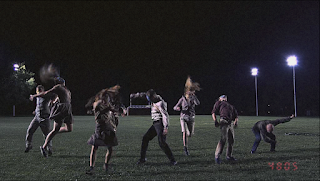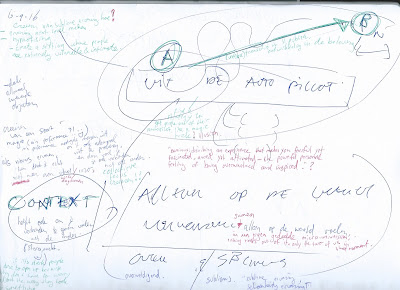This week started with a lecture by Sarah about Situated Scenarios. Planning vs being in the moment.
The main question was; how can we design a scenario, we cannot control? For example, if you make an animation, it is all planned beforehand; you make concept art, create a storyboard, and then you animate. But what if you create a story that can only take place in the moment? Like an immersive theatre experience, or a subtlemob? How do you plan that?
How do you design for an immersive story, that is happening in the moment itself?
What parts do we control, and what do we let go?
Do we need new models for this kind of storytelling?
Sarah also talked about the traditional ways of writing scenarios, and how these ways might actually block us during our creative thinking. (like writing a script, creating a flow chart, storyboard or a mindmap)
The way you write your scenario affects the outcome of your project. How can we visualize an idea, before we start overthinking it, and completely plan it out? What if you let the moment/actors/users/decide the outcome of your project/story?
The tools/mediums we use influence our work and its meaning. "The medium is the message." - Marshall McLuhan
-
Situated design:- "planning in a design context doesn't just have to be a set of rules you follow, but more like a set of instructions to be adapted to the situation that presents itself."
- something that can deal with the situation at hand
- can we learn from traditional/alternative models? (Traditional models being a script & storyboard, flowchart or mindmap)
alternative models:
Conditional Design (manifest by Studio Moniker)
- creating design conditions based on a set of rules
- relies on input from the user
- Process is the product!!
Improv theater:
- happenings.
- Invisible theater:"Invisible theatre is a form of theatrical performance that is enacted in a place where people would not normally expect to see one (for example in the street or in a shopping centre) and often with the performers attempting to disguise the fact that it is a performance from those who observe and who may choose to participate in it, thus leading spectators to view it as a real, unstaged event." https://en.wikipedia.org/wiki/Invisible_theater
(This really speaks to me. Seems like a great way to do social experiments...)
- Flash- or subtlemobs
And Alternate Reality Games.
So, there are many different models/formats we can borrow from(and transcend) to design stories/projects.
And then we played some games (like Weerwolven, DiXit, Storycubes, etcetera) that had immersive storytelling qualities. Trying to understand why and how it immerses you. If immersion is done well, critical thinking tends to shut off.
---
After Sarah's lecture we had a workshop with Nienke and Quirijn. We all came up with research questions for this minor, based on these given subjects: Statement/Vision, Immersion, Technology/Medium, Story, and Methodology.
And we mapped out how we normally do research for projects. What's always important to me during my process is that I ask questions, experiment, reflect, and then ask more questions. Action and reaction.

It was also nice to see how others do research. I saw some elements that I could definitely incorporate into my process.
_______________________________________________________________
Wednesday, 21-9-16
Today we had a lecture by Nienke on Worldbuilding; it basically means you create and develop the world, before you create the story. First you think about the culture, inhabitants, economy, politics, rules, etcetera of the world you want your story to take place in. That way, while you're creating your story, you have all these rules to keep in mind, and so the story will fit perfectly into the logic of this world.
I've never really tried worldbuilding before, so this was all new to me! But it makes sense.
_______________________________________________________________
Friday, 23-9-16
This day was really, really interesting. Marcel and Wander first talked about their backgrounds, and projects they had worked on. And then they talked about sense of smell, and what you can do with it. For example, with smell we can change our perception of an environment, control crowds, trigger memories, manipulate emotions, etcetera.
It's just really fascinating how we can manipulate our brains, by playing with our senses.
So what really sparked my interest was when they started talking about "Synaptic Theatre" -> "developing new authentic & meaningful story experiences by manipulating/stimulating the limbic & neural system."
Basically, using the brain as a medium! This sounds really, really fascinating!! and it's something I would actually love to try out too!
There was also a demonstration of the "Emotiv" headgear, which can "read" your emotions.
Afterwards, we all had to smell 16 scents that were on a table. Some smells were extremely disgusting (like the scent of a sewer) and others were vaguely pleasant (like the smell of soap) But we had to pick the one scent that triggered the most memories. The scent I chose was called "explosion", and yes it smelled like explosion, but it also reminded me of the scent of smoked fish. I remember as a young child being in the woods, and eating smoked salmon, during a holiday.
So then I teamed up with other people who also chose "explosion". (Tijmen, Mattyn and Bert)
We all discussed what memories this scent triggered, and then we developed a story we could tell, using this scent.
We decided to simulate the experience of a campfire, that gets out of control and leads to a forest fire, which is later extinguished (by rain).
Because our audience was blindfolded we had to focus on other senses to convey our story now. So we used touch, sound, and smell (obviously).
Our experience went like this:
- audience is blindfolded, we lead them to their seats.
- they place their hands on a sauna belt, which slowly heats up.
- they hear the sound of a forest, but later you hear the sounds of a forest fire.
- we spread the "explosion" smell with a fan to blow it into the audience's face.
- while the fire sounds get more and more intense we flash lights infront of their eyes to simulate the flickering of fire.
- and then, all of a sudden, we turn the forest fire sounds off, immediately take their hands off the belt and spray water on them. "The fire is extinguished."
Feedback we got was that the way the audience "enters" the experience/story should also be properly directed. Because we hadn't planned beforehand how we would lead them to their seats, it took way too long and it was quite chaotic.
Anyway, telling a story like this was really really fun, and I would like to try it more often!
Afterwards, we had to write another story. We were only allowed to use audio(recorded voice), and the listener was blindfolded. We were going to test if cooling and heating the body, according to the heatmaps below, affects the experience, immersion, and the emotions felt while listening to the story.
So for example, if we wanted our listener to feel angry during the story, we would apply heat to the upper body and fists.
First the listener listened to the story without us applying heat or cold. Then they listened for a second time while we applied heat & cold, to see how different the experiences would be.
I also listened to another group's story and I did indeed notice that the temperature changes affected my mood and how I felt during the story.
_______________________________________________________________
All in all, a very interesting week! I discovered a lot of things that I can try out again in the future.

























